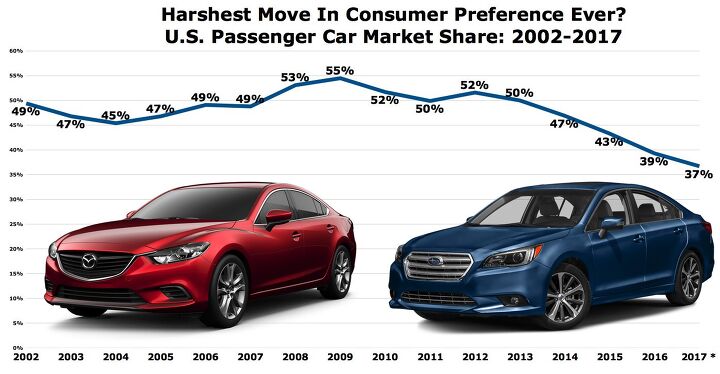How Far and How Fast Has U.S. Passenger Car Market Share Fallen? So Far, and so Fast
37 percent of the new vehicles sold in the United States in the first seven months of 2017 were passenger cars. That’s correct. 63 percent of the new vehicles now sold in America are pickup trucks, SUVs, crossovers, and vans.
But how did we get to this 37-percent basement? When did we get here? How long did it take to get here? And is it really the basement?
Answers: we got here with the rise of crossovers, we began the approach to our current destination in 2013 (though the rate at which we approached has rapidly increased), and we might not be at the end of our journey quite yet.
“This was the harshest move in consumer preference the industry has ever seen,” Toyota executive vice president for North American sales, Bob Carter, tells Wards Auto.
To critics who suggest Toyota, and the industry at large, didn’t see the move coming, Carter points right at the auto industry’s own trend-spotting. “Did the industry see it coming? Yes, or you wouldn’t have what you have today.”
New vehicles in new sectors, such as Toyota’s C-HR and the RAV4 Hybrid, don’t simply fall from the sky. The new vehicles Toyota is selling this year are the fruit of a product cycle that began half a decade ago.
Whatever the cause of the shift — and there are fuel economy regulations and fuel prices and AWD marketing all at play, among other factors — the shift has been noteworthy both for the degree to which traditional passenger cars have lost their hold on the market and because of the speed with which they lost that hold.
Now the mission is to determine whether the shift is complete, whether a 37/63 split represents the basement for passenger cars. Carter has said in the past that the current state of passenger car market share is likely to hold steady.
The investment in Toyota’s Kentucky Camry plant — there are now more workers at the Georgetown plant than ever before — speaks to Toyota’s belief that the car sector has reached bottom.
A five-year trend suggests otherwise.
[Image: Toyota]
Timothy Cain is a contributing analyst at The Truth About Cars and Autofocus.ca and the founder and former editor of GoodCarBadCar.net. Follow on Twitter @timcaincars.
More by Timothy Cain
Latest Car Reviews
Read moreLatest Product Reviews
Read moreRecent Comments
- Calrson Fan Jeff - Agree with what you said. I think currently an EV pick-up could work in a commercial/fleet application. As someone on this site stated, w/current tech. battery vehicles just do not scale well. EBFlex - No one wanted to hate the Cyber Truck more than me but I can't ignore all the new technology and innovative thinking that went into it. There is a lot I like about it. GM, Ford & Ram should incorporate some it's design cues into their ICE trucks.
- Michael S6 Very confusing if the move is permanent or temporary.
- Jrhurren Worked in Detroit 18 years, live 20 minutes away. Ren Cen is a gem, but a very terrible design inside. I’m surprised GM stuck it out as long as they did there.
- Carson D I thought that this was going to be a comparison of BFGoodrich's different truck tires.
- Tassos Jong-iL North Korea is saving pokemon cards and amibos to buy GM in 10 years, we hope.



































Comments
Join the conversation
I envy Toyota, Nissan, and Honda. Even in this age of the SUV, they still thousands of sedans and compacts each year. In fact the Camry and Accord easily outsell most GM trucks and SUVs.
Woo hoo! The station wagon and hatchback have triumphed in the end! Sure, we have to give today's wagons a little excess ground clearance and call them a Crossover, but these are just tall, practical station wagons. Hatchbacks are dead, unless you put a hybrid power-train in them and then you have The Prius! The two most rational configurations for flexibility, usability, drive-ability and efficiency have won!!!! Meanwhile, stupid configurations like two door coupes and big on the outside, small on the inside sedans are getting run out of town. Time to party!%$$%^*)&)&(*)(*&_!